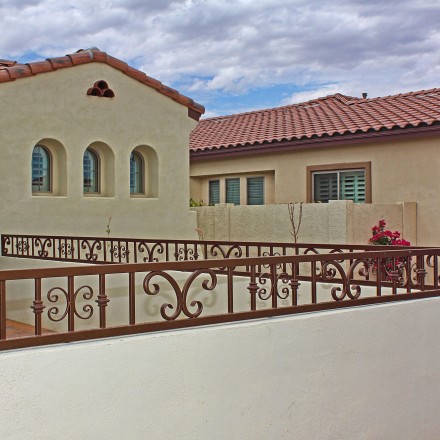Lights. Camera. Action! The Home Hunter TV on ABC 15
Now you can see First Impression Ironworks on Network TV! We had an incredible time stepping into the spotlight for […]
If you are looking for an affordable addition to your home décor which can be both aesthetically pleasing and safety conscious, give serious consideration to the addition of a wrought iron or glass railing to your existing stairway. Both of these options are gaining popularity over the older, standard wooden railings and are quickly making headway in the home improvement and design realms. Here are some basic terms and ideas you need to consider before having such a railing installed in your home.

Once you are equipped with the lingo and jargon of iron railings, it is easy to contact one of our Design Consultants to look at customizing a railing that is just right for your home.
Call 480-339-6145 for a FREE in-home design quote or use the form below.
"*" indicates required fields
Don't waste your time driving to a showroom. We'll work around your schedule and bring the showroom right to your home. Pick a preferred day and time for your free-in-home design quote below.
We're looking forward to seeing you at the showroom
Call 480-339-6145 for a FREE in-home design quote or use the form below.
Activate Your Promo Code NOW!
Then we'll schedule your FREE IN HOME DESIGN CONSULTATION for your to select your door.
Activate your promo code today and get FREE Design, Free Delivery and FREE Installation now through November 8, 2024.
Activate your promo code today and get FREE Design, Free Delivery and FREE Installation.
Get Up To $500 OFF* With Hinged Glass Panels & Iron Handle Designs
Activate Your Promo Code NOW!
$500 OFF* + Bonus Upgrades - Iron Entry Doorsor $150 OFF* Select Iron Security Doors
Activate your promo code today and get FREE Design, Free Delivery and FREE Installation.
Activate your promo code today and get FREE Design, Free Delivery and FREE Installation.
Activate your promo code today and get FREE Design, Free Delivery and FREE Installation.
Activate Your Promo Code!
ACTIVATE YOUR PROMO CODE - Choose from our Summer Season Specials of Iron Security Doors, Iron Entry Doors and Iron Gates and more.
Call 602-345-7533 or use the form below to discuss your door.
Activate your promo code today and get FREE Design, Free Delivery and FREE Installation.
Recieve our VIP Total Care Maintenance Plan Pricing.